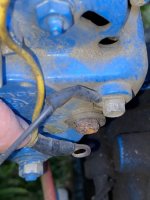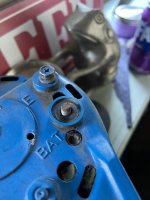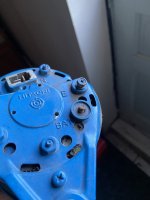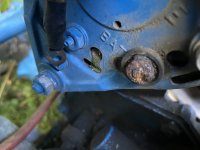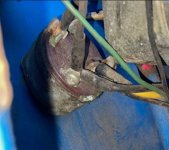You are using an out of date browser. It may not display this or other websites correctly.
You should upgrade or use an alternative browser.
You should upgrade or use an alternative browser.
Ford 1700 just quit while brush hogging
More options
Who Replied?
/ Ford 1700 just quit while brush hogging
#11
TractorTech
Elite Member
- Joined
- Jan 26, 2012
- Messages
- 2,994
- Location
- California
- Tractor
- Ford 7710, Ford 550, Ford 1910, Ford 4430, KD Forklift, Ford LGT17H, New Holland L255 Skidsteer
Great question, but the 1700 has only one safety switch and that is the neutral start switch. The 20 series was the first with the added safetys beyond starting.Just from my experience. Did you shut off the PTO. I know my 1920 won’t start with it on. Does your 1700 have lights, and if it does do they turn on.
JC-jetro
Elite Member
Just from my experience. Did you shut off the PTO. I know my 1920 won’t start with it on. Does your 1700 have lights, and if it does do they turn on.
That is not correct statement for 1700. On many tractors such as my Kubota if PTO lever/switch is on then I cannot start the tractor.
On 1700 PTO is transmission driven and is purely mechanical. I can start the tractor both in gear or Neutral or even PTO engaged just as I long I compress the clutch pedal fully where it makes the neutral safety switch. That is no different than let say on my manual transmission car that it can be in 1st gear and I can still turn it on but clutch must be fully pressed.
Last edited:
JC-jetro
Elite Member
I corroborate that with my 1700. I was actually in the barn and hot conductor going to the dash is so well protected following the chassis routing but there is a slight possibility some brush got caught on the bottom and jerked a ground or hot wire. OP need to follow the routing and check them out. He need to have voltage right at the switch that he can easily check it with a 12 volt light probe.Great question, but the 1700 has only one safety switch and that is the neutral start switch. The 20 series was the first with the added safetys beyond starting.
OP
jpilk99
Gold Member
- Joined
- Feb 19, 2011
- Messages
- 380
- Location
- Bolton, MA
- Tractor
- 1983 Ford 1700, 4WD, 770 Loader, Woods backhoe, Woods brush hog,etc.
I believe I found the issue. I chased the POS wiring to the back of the alternator and found the “BAT” pole was naked, with what appears to be a broken threaded post, rust nut, and a connector hanging in the breeze; assumedly previously connected to said BAT post. See pics.I corroborate that with my 1700. I was actually in the barn and hot conductor going to the dash is so well protected following the chassis routing but there is a slight possibility some brush got caught on the bottom and jerked a ground or hot wire. OP need to follow the routing and check them out. He need to have voltage right at the switch that he can easily check it with a 12 volt light probe.
Only question: seems I have to open up alternator to get to that threaded bolt to replace, and I do not enjoy these jobs - keeping armatures in place and brushes/magnets from springing out of place. Wish I could somehow thread a new nut with some connecting hardware to “make the connection” with the threaded post…. Maybe something at Lowes/hardware shop??
Attachments
JC-jetro
Elite Member
Yup, I think you are in the right track. i don't recommend taking anything apart. I zoomed in and it seems you have enough thread on the positive post. I just clean it up good with dremmel and wire brush and find a nut that fits it. I would wire brush the eyelet or crimp a new one as they are readily available in Lowes or even HF. You will not be able to find that stud easily and once you open it up you are in a point of no return. Below is how the wires need to land. It would not hurt to smear a thin coat of grease on the new bolts to mitigate the future rust if you wish. I hope she'll start with the first try.I believe I found the issue. I chased the POS wiring to the back of the alternator and found the “BAT” pole was naked, with what appears to be a broken threaded post, rust nut, and a connector hanging in the breeze; assumedly previously connected to said BAT post. See pics.
Only question: seems I have to open up alternator to get to that threaded bolt to replace, and I do not enjoy these jobs - keeping armatures in place and brushes/magnets from springing out of place. Wish I could somehow thread a new nut with some connecting hardware to “make the connection” with the threaded post…. Maybe something at Lowes/hardware shop??
OP
jpilk99
Gold Member
- Joined
- Feb 19, 2011
- Messages
- 380
- Location
- Bolton, MA
- Tractor
- 1983 Ford 1700, 4WD, 770 Loader, Woods backhoe, Woods brush hog,etc.
Dang. It still won’t run - zero electricals with the battery ready 12.6v. I thought for sure that wire hanging out in space off the BAT pole on the back of the alternator was it.
Kept tracing up to the back of the dash, don’t see anything obvious (disconnected or broken wire). Ground cable is solid to frame. Fuses are fine.
No idea what to check next…
Kept tracing up to the back of the dash, don’t see anything obvious (disconnected or broken wire). Ground cable is solid to frame. Fuses are fine.
No idea what to check next…
OP
jpilk99
Gold Member
- Joined
- Feb 19, 2011
- Messages
- 380
- Location
- Bolton, MA
- Tractor
- 1983 Ford 1700, 4WD, 770 Loader, Woods backhoe, Woods brush hog,etc.
PTO is disengaged. Good ideaJust from my experience. Did you shut off the PTO. I know my 1920 won’t start with it on. Does your 1700 have lights, and if it does do they turn on.
TractorTech
Elite Member
- Joined
- Jan 26, 2012
- Messages
- 2,994
- Location
- California
- Tractor
- Ford 7710, Ford 550, Ford 1910, Ford 4430, KD Forklift, Ford LGT17H, New Holland L255 Skidsteer
Again, the 1700 doesn’t have a PTO safety switch, but good idea to disengage.
Do you have a voltmeter or test light? Using one of those, test for voltage at the starter big top lug. If you have 12v +/-, follow the smaller lead off of the lug up to the ignition switch and check for breaks in that line. Check for voltage at the ignition lug. This is a the trace to look it if you haven’t done so already. If any of those points fail to produce 12v, then you have your problem narrowed down.
Do you have a voltmeter or test light? Using one of those, test for voltage at the starter big top lug. If you have 12v +/-, follow the smaller lead off of the lug up to the ignition switch and check for breaks in that line. Check for voltage at the ignition lug. This is a the trace to look it if you haven’t done so already. If any of those points fail to produce 12v, then you have your problem narrowed down.
OP
jpilk99
Gold Member
- Joined
- Feb 19, 2011
- Messages
- 380
- Location
- Bolton, MA
- Tractor
- 1983 Ford 1700, 4WD, 770 Loader, Woods backhoe, Woods brush hog,etc.
When you say, "check for voltage at the ignition lug" I'm assuming you mean one of the pins on the back of the ignition switch? Can you tell on the image I attached which is that lug? (Sorry if I'm a stooopid)Again, the 1700 doesn’t have a PTO safety switch, but good idea to disengage.
Do you have a voltmeter or test light? Using one of those, test for voltage at the starter big top lug. If you have 12v +/-, follow the smaller lead off of the lug up to the ignition switch and check for breaks in that line. Check for voltage at the ignition lug. This is a the trace to look it if you haven’t done so already. If any of those points fail to produce 12v, then you have your problem narrowed down.
